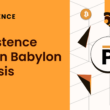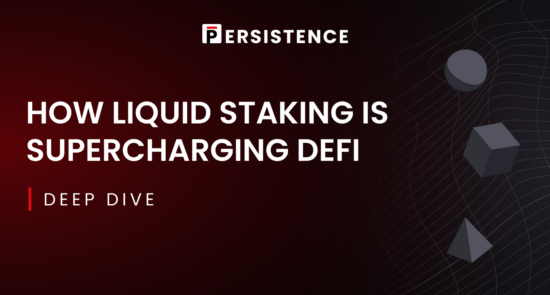DeFi (decentralized finance) has vastly enhanced opportunities for users across the financial landscape, offering accessible and highly attractive yield-generating vehicles to the majority of the global population through the blockchain. At its peak in November 2021, DeFi had grown to $240B+ TVL across various flourishing ecosystems (currently ~$100B).
Before DeFi’s emergence, staking has been a popular yet conservative strategy where users leverage their idle digital assets to earn attractive yields while also providing security to the underlying network. Since its inception, the industry has seen a phenomenal rise in its overall growth, amassing over $115 billion in current global staked value and 4.8 million stakers worldwide to date.
With staking attracting such a large number of participants in their pursuit to earn rewards and provide better network security, significant potential TVL and activity have been siloed away from the DeFi landscape in PoS. Reversely, the emergence of DeFi has highlighted the limited utility that staked assets provide compared to the composability and financial opportunities available in the vibrant DeFi space.
It’s also important to note that PoS chains containing high TVL with a limited amount of staked assets are generally considered to be less secure, while, PoS chains that have high security but lower TVL may be viewed as lacking adoption in the eyes of the public.
Enter liquid staking, enabling a flood of additional liquidity (and users) to enter DeFi by allowing PoS token holders to stake and participate in DeFi at the same time. Liquid stakers receive liquid-staked representative tokens that can be used across DeFi ecosystems, while earning rewards from their underlying staked tokens and supporting the underlying network/s.
Liquid staking is opening the door to new use cases and opportunities for ecosystem participants, providing the best of both worlds when it comes to yield generation and utility.
Enriching DeFi’s Long-Term Potential
The fact that liquid staking offers additional liquidity (in the form of liquid-staked assets) encourages an injection of liquidity across various DeFi ecosystems, as users explore ways to utilise these assets for additional opportunities.
Given liquid staking’s promising use cases, the sector is poised to become a prime catalyst to accelerate DeFi’s growth by tapping into the current $115 billion in global staked asset value.
Moreover, since liquid staking presents an attractive alternative to traditional staking, it has great potential to attract a completely new market of PoS token holders new to both staking and DeFi — increasing traction of both sectors.
Liquid staking puts forth a new opportunity to bootstrap billions in additional liquidity and onboard DeFi users across the globe — the value proposition is clear, and opportunities are endless.
Persistence is on a mission to bring this to fruition through a comprehensive liquid staking ecosystem covering asset issuance to utilisation in DeFi, enabling users around the globe to reap the benefits of liquid staking.
Benefits to DeFi Participants
Liquid staking unlocks liquidity for staked assets by issuing representative stkASSETs (e.g. stkATOM and stkETH) that can be used across DeFi ecosystems for further opportunities while the underlying staked assets are also accruing staking rewards. By doing so, it offers several promising benefits to both DeFi users and protocols alike.
DeFi Users
Liquid staking essentially allows users to double their potential to earn. By receiving rewards from their staked PoS assets and also additional capital liquidity to use across other DeFi protocols, liquid stakers are able to take advantage of multiple yield generation opportunities — thereby maximising capital efficiency.
Additionally, the continued emergence of liquid staking will improve the experience for users across DeFi protocols that support liquid-staked assets. This is particularly true when it comes to the overall trading experience (due to increased liquidity, reduced slippage, etc.) and greater accessibility when it comes to asset utilization.
DeFi Protocols
Users flooding into DeFi to utilize their liquid-staked assets would contribute to a surge in activity and TVL (Total Value Locked) across DeFi protocols. Users will be looking to deploy their liquid-staked capital into different areas to take advantage of the additional earning potential and will be keener to participate as a result.
It will also spur an entirely new era of innovation, with DeFi protocols (and ecosystems such as Persistence) aiming to deploy the necessary infrastructure to build and support the applicability and longevity of liquid-staked assets.
As a whole, users directly benefit from increased opportunities and rewards, while DeFi protocols receive higher activity and liquidity derived from both new and existing users. It’s a win-win that will allow DeFi ecosystems (and PoS) to mutually thrive.
The emergence of liquid staking will enable market participants to unlock the full potential of their PoS assets and reap the benefits of newfound liquidity, while also encouraging greater interoperability between protocols and networks.
Unlocking Interchain Liquidity
Liquid staking facilitates and encourages interchain value and liquidity transfer, through the deployment of liquid-staked assets within the Cosmos IBC ecosystem.
pSTAKE’s Cosmos-based liquid-staked assets will be issued on the IBC-enabled Persistence chain and will be transferable across IBC-compatible networks, boosting liquidity and enhancing the utility of Cosmos ecosystem DeFi.
There are also plans to issue other PoS assets such as stkBNB, stkSOL, stkAVAX, and many more on their respective native blockchains. Once live, these liquid-staked assets will instantly be able to be transferred and utilized across various DeFi applications within these environments.
Risk Mitigation
Liquid stakers receive instant additional liquidity which they can use to partake in multiple yield generation opportunities from the get-go. In market downtrends, this can often be especially attractive to crypto holders.
Many already consider the basic staking of assets to be a hedge against potential losses during market downturns — liquid staking amplifies opportunities during movement to the downside. This is because liquid stakers have two different assets (staked native asset and stkASSET) that are both earning passive income, basically doubling the opportunity to earn even if the market is negative.
So how does this add value to the DeFi space? Liquid staking encourages market participants to remain in their positions since they are earning greater yield and thus are less affected by market downturns. Since the crypto market’s peak in November 2021, the TVL of staked assets has already seen around a 56% decline — this could have been significantly less if liquid staking was more prominent already.
As liquid staking continues to grow and become further integrated into broader DeFi ecosystems, extra liquidity will be injected into protocols to help bring in more users.
This will encourage DeFi protocols to continue building and improving upon their architecture, meaning users will be more incentivized to continue engaging and participating in those respective ecosystems, even when markets may take a turn to the downside.
Persistence: Supercharging PoS and DeFi
Persistence is committed to constantly bringing liquid staking innovation to popular PoS chains and DeFi ecosystems. Our liquid staking hub is setting the stage to become front-and-center in the space for liquid-staked assets. Currently in the works for the Persistence ecosystem are other primitive DeFi applications, such as a lending and borrowing protocol and interchain DEX for seamless swaps.
With over $16.5 million TVL for staked assets, 5,600 users, and almost $340,000 in stkASSET Sushiswap pool liquidity, pSTAKE is leading the charge and already beginning to gain traction. The rise in the adoption of pSTAKE is a testament to the demand from stakers to unlock additional yield in DeFi.
stkASSET utility is growing, and further integrations are coming from both within and outside of the Persistence ecosystem that will open the door for more DeFi opportunities. Moreover, the team is in the process of exploring and implementing the addition of new stkASSETs.
ETH liquid staking recently went live on mainnet — users can now stake ETH to mint, trade and provide liquidity with stkETH. Next up are stkSOL, stkAVAX, and stkBNB, which represent liquid-staked SOL, AVAX, and BNB, respectively — these are currently in the process of being implemented. pSTAKE’s launch on Persistence chain (IBC) and liquid staking support for more Cosmos ecosystem assets are also due in Q2/Q3.
With that and much more in the pipeline, Persistence and liquid staking are poised to make a notable impact on DeFi moving further into 2022 and beyond.
About Persistence
Persistence is a Tendermint-based, specialised Layer-1 network powering an ecosystem of DeFi applications focused on unlocking the liquidity of staked assets.
The Persistence chain facilitates the issuance and deployment of liquid-staked stkASSETs, allowing users to earn staking rewards while participating in DeFi primitives, such as lending/borrowing and liquidity provisioning on DEXs.
Persistence aims to offer a seamless staking and DeFi experience for PoS (Proof-of-Stake) users and enable developers to build innovative applications around stkASSETs.
Join Our Movement
Twitter | LinkedIn | Telegram | YouTube | Reddit | [email protected]





